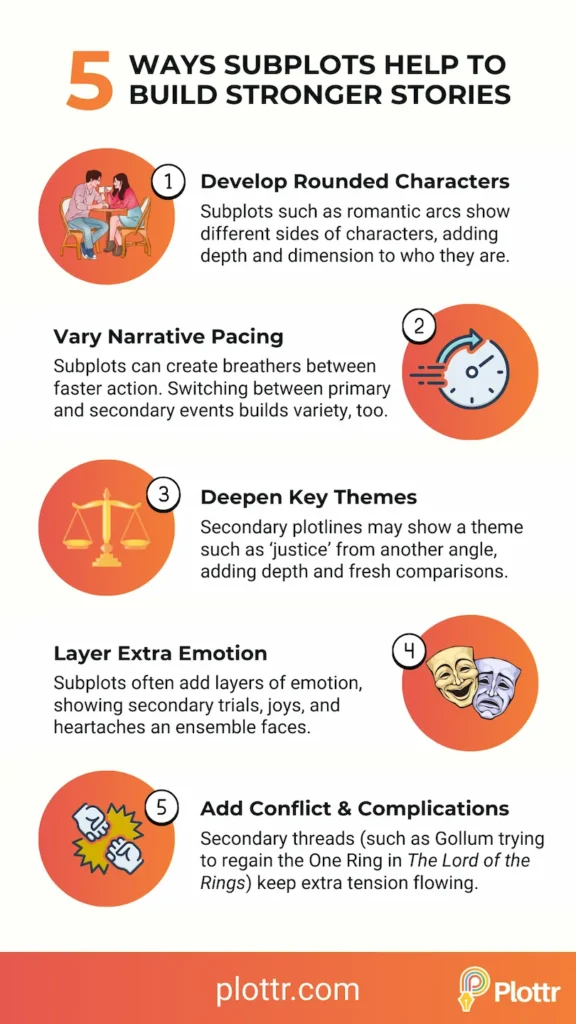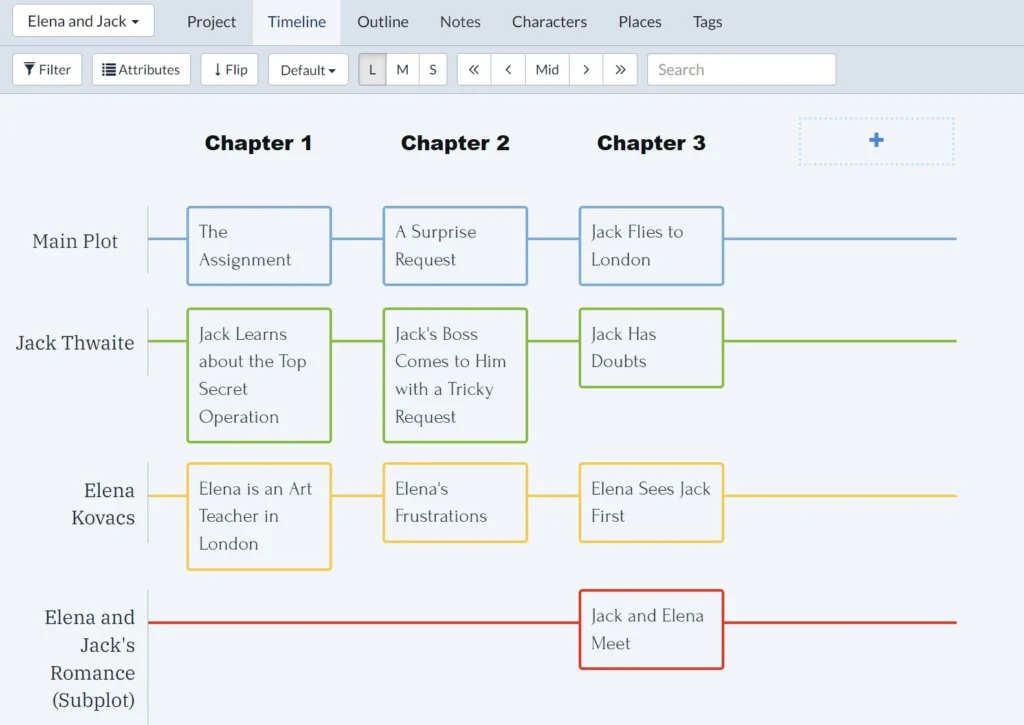Subplots are like supporting actors in a great story. They steal scenes, stir up trouble, and show sides of your characters your reader might never see otherwise. Discover what subplots are, why they matter, and how to plan them in Plottr.
Key Takeaways
A subplot in fiction connects to the main plot of a story. They often add depth and echo themes. A subplot:
- Helps to develop characters (including supporting roles)
- Helps you vary pacing
- Deepens themes
- Builds deeper emotional layers
- Adds intriguing conflict or complication
Keep reading for how to use subplots in Plottr, and learn what authors say about them.
What is Subplot?
A subplot is a secondary storyline that grows with your main plot. It often involves side characters, or shows another side to your mains.
For example, a romantic arc may add further stakes in a thriller or action story.
Subplots can echo your main theme, flip it on its head, or add something new. But no matter what, they always tie back to the main story.
Why are Subplots Useful in Stories? 5 Benefits
Subplots Aid Character Development
Side plots reveal new sides of characters. They may contribute to motivations, causing them to act.
Example: In Season 3 of The White Lotus, Gaitok is a hotel guard who likes Mook, a coworker. Yet when he questions the harsh parts of his job, Mook sees him as weak.
Mook and wider society push Gaitok to act tough. This leads him to make tragic choices that affect the main story. His love for Mook drives him to commit a reluctant act, at a price to him and others.
Subplots Add Pacing Variety
A subplot gives readers a breather. Or it may build suspense as larger conflicts near.
Example: In The Lord of the Rings, Gollum wants to get the One Ring. This secondary conflict keeps the story moving, building suspense before bigger events.
Subplots Reinforce Themes
Subplots that mirror or contrast to your story’s main themes strengthen them.
Example: In Crime and Punishment by Dostoevsky, the main character, Rodion, kills a pawnbroker. He claims it’s for the greater good, since she takes advantage of people in need.
In a subplot, Sonia Raskolnikov, a young woman who Rodion meets, turns to working as an escort to support her poor family.
Rodion suffers due to sacrificing others to serve his ideals. Sonia, on the other hand, sacrifices herself. Both characters wish to serve others. Yet the choices they make create anguish and guilt.
Subplots Build Emotional Layers
Subplots make stories hit harder, as they explore family tensions, hidden love and other scenarios.
Example: In Little Women, Jo March’s writing career is a subplot that adds heart and depth. While the main story focuses on family, her dream to be a writer shows us her hopes, fears, and drive. This makes her journey feel even more real.
Subplots Add Conflict and Tension
Tension is gold for storytelling. Subplots introduce obstacles, rivalries and desires that add further difficulty.
Example: In book four of A Song of Ice and Fire by George R. R. Martin, Cersei Lannister and Margaery Tyrell clash in a tense power struggle. Their rivalry, full of schemes and ambition, raises the stakes and drives major political fallout.

Given all the useful things subplots do, how can you create and see them in Plottr?
How to Create and Map Subplots in Plottr
Plottr makes subplot planning visual and easy to manage.
Create a New Plotline Stating Your Subplot’s Purpose
Add a new subplot in the timeline view and give it a clear name — like “Elena and Jack’s Romance” — so it’s easy to track.

To Create a New Plotline:
- Hover over the + to the left of the plotlines in Timeline view
- Click the + to start a blank plotline for your subplot
- Or, click ‘Use Template’ to start from one of 30+ plot templates
Color-Code Plotlines to Show Their Role
Color-code your plotlines to visually separate subplots from the main plot or show their role.
For example, use a bold color like red for romance or conflict, or pick a shade of blue to match a key theme in your story.
Tag Scene Cards with Connected Subplots
Tagging is a simple but powerful way to track subplots in Plottr. Create a “Subplots” category in the Tag view. Next, make a tag for each subplot. Use those tags to mark any scene where the subplot appears, even in the main plotline.
This makes it easy to see wherever your subplots have the spotlight.
Use Templates to Compare Subplot Arcs with Proven Plot Structures
With Plottr, it’s so easy to compare subplot ideas to proven story structures.
For example, you could take a romantic subplot and lay it out next to Gwen Hayes’ Romancing the Beat structure.

Subplot Examples from Classic Books
Here are subplot examples to show how this storytelling tool works in action:
The Great Gatsby by F. Scott Fitzgerald: Tom’s affair adds tension and reveals class hypocrisy.
In To Kill a Mockingbird by Harper Lee, Boo Radley’s subplot supports the main themes of prejudice and empathy. The kids spread wild stories about him until they learn who he really is.
Little Women by Louisa May Alcott: Jo’s writing career subplot highlights ambition and independence, and how uphill it is to champion both as a woman living in her era.
Jane Eyre by Charlotte Brontë: The mystery of the woman in the attic builds suspense. It connects to bigger themes, such as the dark side of power dynamics between men and women.
Where to Find Subplot Ideas
How can you find subplot ideas that make your story deeper and more interesting?
- Compare and contrast themes. If one character is selfish, maybe another is selfless to highlight the tension between values
- Explore secondary character goals. What does a side character want that helps or hinders the main character’s journey?
- Mirror the main character’s arc. Create a subplot where another character faces a similar challenge but makes a different choice
- Add a romantic arc. Romance can soften a heavy plot or add emotional risk, especially if it tests loyalties
- Use family conflict. Create tension with parents, siblings. The TV series Succession did this expertly
- Reveal a secret. A character hiding something important creates suspense
Where do you find subplot ideas? Comment below!
What Authors Say about Subplots
What do authors say about subplots?
Jeffrey Deaver: “In suspense novels, even subplots about relationships have to have conflict.” Source: Q&A with Jeffrey Deaver.
John Truby: “Subplot […] improves the character, theme, and texture of your story. On the other hand, it slows the desire line — the narrative drive. So you have to decide what is most important to you.” Source: The Anatomy of Story: 22 Steps to Becoming a Master Storyteller
Sherryl Clark: “The challenge is to work out what is a real subplot — one that will deepen plot, characters and probably backstory — and one that is simply a meandering or dead-end path. One way to work it out is to understand how subplots work with your main plot. They tend to complement, complicate or contrast.” Source: Medium.
Start Layering in Extra Intrigue
Ready to create subplot magic? Track every thread and subplot with ease in Plottr. Start now with a free 30-day trial.







Comments